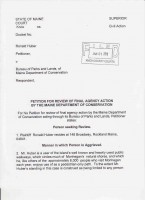Legal Action. Until new state wind rules are set and enforced during decision making, Maine’s Bureau of Parks and Lands has no business selecting and designating Maine offshore wind energy test areas. Local media coverage: Herald Gazette and Maine Public Radio News
Local media coverage: Herald Gazette and Maine Public Radio News
That’s what conservation activist Ron Huber wants Maine Superior Court to confirm. Huber filed in Knox County Superior Court on January 25, 2010 , asking Justice Jeffrey Hjelm to suspend Bureau of Parks & Lands December 14, 2009 decision approving location of the state’s offshore wind energy test center 2 miles south of Monhegan, until conservation rules based on Maine’s new energy laws are finalized. The new laws, 12 MRSA 1868 “Identification of Offshore Wind test areas and MRSA 35-A, Chapter 34-A: Expedited Permitting of Grid scale Wind Energy Development require close community coordination and a commitment by the Wind Test Center to conduct detailed observation of ongoing scenic and conservation impacts on the land, air and sea in the test area vicinity.
BPL’s Submerged Lands Program is otherwise setting poor precedent: absolving present developers in advance with a vague general permit when it comes to scenic and natural resources of state and national significance; instead of defending the irreplaceable. Let the designers of the energy platforms make the compromises, not Nature. It is R&D the University proposes to practice here; let academics from all disciplines take part, not only the energy engineers.
A deep ecologist, Huber asked Maine Superior Court to grant him standing based on his religious pastoralism , or as he termed it “faith based bay stewardship.” in the practice of which he has helped fend off industrial threats to lobster grounds in lower Penobscot Bay and groundfish nurseries and brackish water diadromous fish staging areas in upper Penobscot Bay
rule on whether Maine Bureau of Parks & Lands Director Willard Harris followed two recently passed staten on December 14, 2009, he authorized the Monhegan test area, one of three in Midcoast and southern Maine waters. Read Ron’s media briefing explaining why he decided to file the case, his relationship with Monhegan – and media reactions to the case so far.
The state university’s R&D team should be as much researching impacts to fish, bird , marine mammal and water quality, in addition to prototyping new windblades for efficiency. Scientists, engineers, biologists and naturalists should be gleaning every bit of social and -biological data out there, before during and after each project, not confining themselves to solving engineering problems, important as they are. Click picture of complaint’s first page for complete 9 pg pdf of legal petition filed January 25th.
Background. Maine’s Legislature and Executive Branch have authorized the University of Maine to occupy a roughly 2 square mile deepwater tract 2 miles “south and seaward” of Monhegan Island to test build two deepwater floating wind turbines: a 100 kilowatt wind tower and a ten kilowatt one. Funding sufficient to get the project underway has been secured. As politicians, agency staffers, academics, entrepeneurs, NGOs and even two high powered public relations firms are already hard at work on this, so too should the interested public be! Information is power. Charge yourself up here: Links to documents, reports, charts, maps, photographs, deadlines, contacts, key personnel involved and other information sufficient to equip the viewer for meaningful involvement in this process, and provide a forum for the sharing and vetting of important information as it arises.
Voices of the Wind Rush. Online audio of speakers at Maine Offshore Energy ’09 11/29/09 , at Energy Ocean 2009 June 15-18 , ’09 at the 2009 ME Fishermen’s Forum Ocean Energy Workshop 3/7/09 and on January 20, 2010: speakers & legislators at hearing on wind energy bill LD 1504 before the Joint Standing Committee on Utilities and Energy